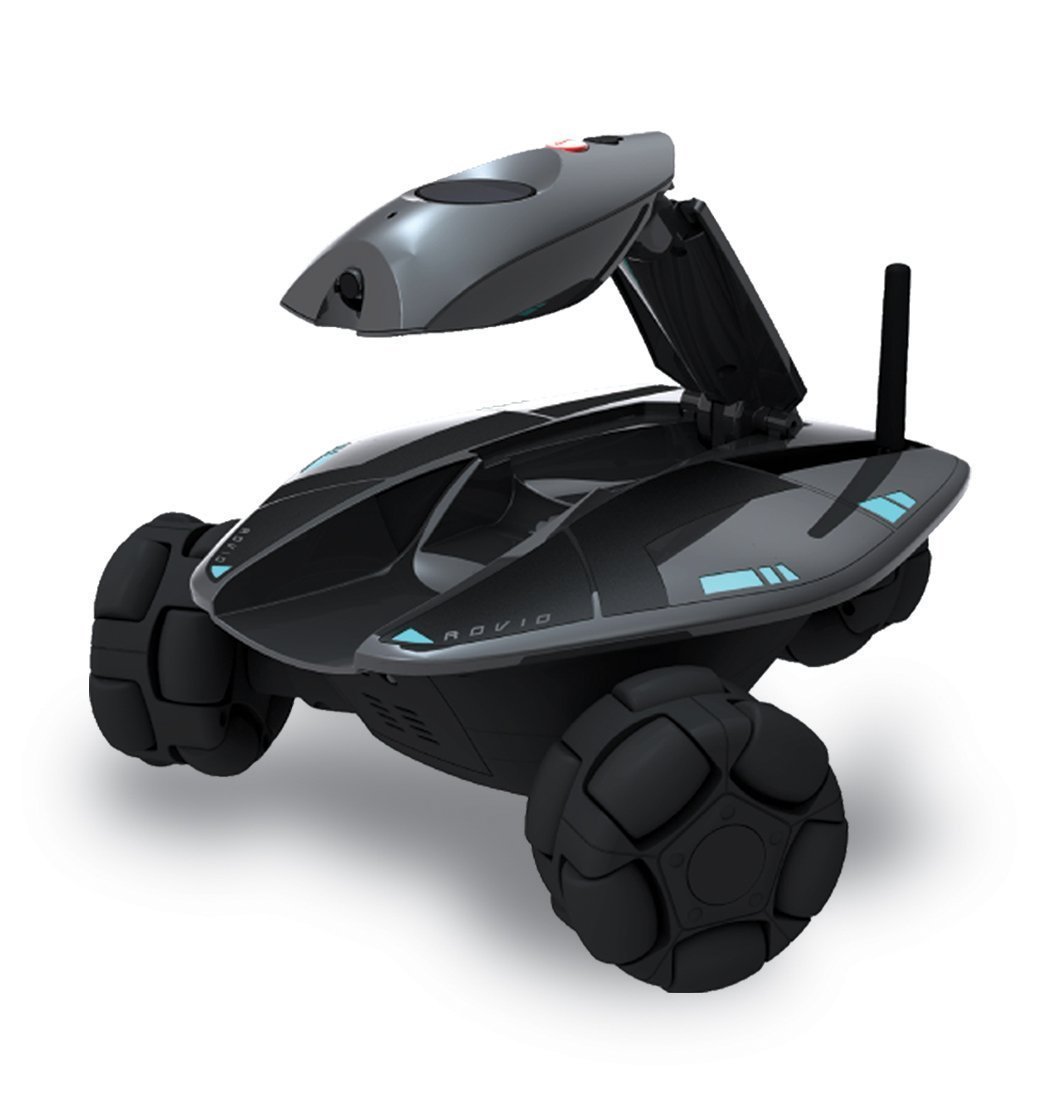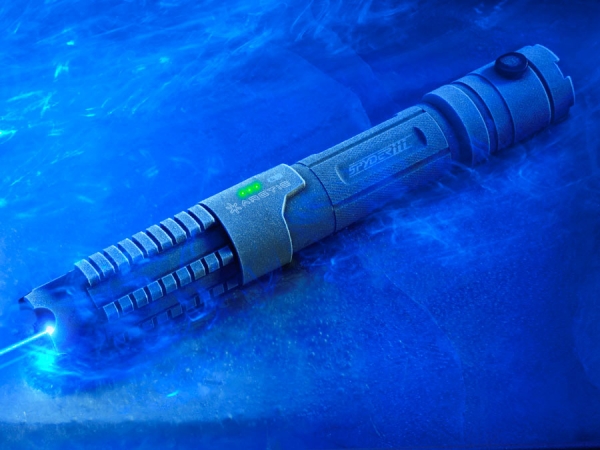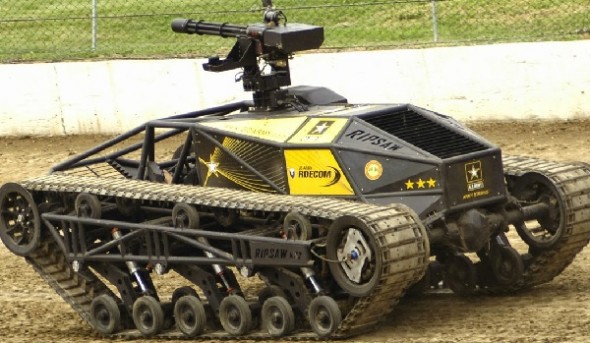It looks like you're using an Ad Blocker.
Please white-list or disable AboveTopSecret.com in your ad-blocking tool.
Thank you.
Some features of ATS will be disabled while you continue to use an ad-blocker.
7
share:
Here we go folks, Russia has deployed fully autonomous mobile sentry robots to protect five of their missile bases. Say hello to the soldier of the
future! The so called "Mobile Robotic Complex
The so called "Mobile Robotic Complex
NewScientist
Here is a short video (in Russian) of the robot at the arms fair.
If you ask me this little robo-tank looks like it was designed to hold a much larger payload than a heave machine gun and probably could have a proper turret with a cannon or a rocket launcher, mix that with modern armour and no need for a crew compartment and its bound to be pretty tough! If Russia thinks it is ready to leap into autonomous mechanized combat then the logical thing for any competitor to do would be to build a bigger better one, but what will the competitors answer to this be I wonder?
I couldn't find anything else about this anywhere so any further information would be greatly appreciated.

Last month, Dmitry Andreyev of the Russian Strategic Missile Forces announced that mobile robots would be standing guard over five ballistic missile installations. These robots can detect and destroy targets, without human involvement. Russia, it seems, is taking the lead in a new robotic arms race.
The robot sentry, aka the "mobile robotic complex", was developed by Izhevsk Radio Plant, a company based 1200 kilometres east of Moscow. It weighs around 900 kilograms and has cameras, a laser rangefinder and radar sensors. For fire power it has a 12.7-millimetre heavy machine gun, with optional smaller weapons. It is quick too, hitting speeds of 45 kilometres per hour on a petrol engine. It can operate for 10 hours, or switch to sleep mode for a week.
The makers put the sentry robot through its paces at an arms fair in Russia last year. Andreyev describes the robots as being able to engage targets in automatic as well as semi-automatic control mode. US policy, on the other hand, says a person has to authorise when weapons are fired. Drones don't fire missiles on their own, but act as remote launch platforms for human operators.
NewScientist
Here is a short video (in Russian) of the robot at the arms fair.
If you ask me this little robo-tank looks like it was designed to hold a much larger payload than a heave machine gun and probably could have a proper turret with a cannon or a rocket launcher, mix that with modern armour and no need for a crew compartment and its bound to be pretty tough! If Russia thinks it is ready to leap into autonomous mechanized combat then the logical thing for any competitor to do would be to build a bigger better one, but what will the competitors answer to this be I wonder?
I couldn't find anything else about this anywhere so any further information would be greatly appreciated.
This is just one of the horrifying things about the future that has always bothered me. Taking human beings out of war, has the unintended
consequence of making going to war that much easier. If you are losing robots, and not humans, you'll declare war, easier.
Doing this, however, causes all sorts of problems. Even if the two sides are both utilizing robots, you have civilians to think about, even in rural areas. And, what if it's only one side with robots?
Ugh...
And yeah, Russia has been doing a TON of R&D on robots. Trust me, there are already about 20 variants for that little robot, and you guessed a couple of them, already. Turrets, missles, mortars, AA guns, etc.
Doing this, however, causes all sorts of problems. Even if the two sides are both utilizing robots, you have civilians to think about, even in rural areas. And, what if it's only one side with robots?
Ugh...
And yeah, Russia has been doing a TON of R&D on robots. Trust me, there are already about 20 variants for that little robot, and you guessed a couple of them, already. Turrets, missles, mortars, AA guns, etc.
edit on 28-7-2014 by Catacomb because: (no reason given)
The dawn of SkyNet. Watch out for the terminators, they should arrive soon to kill anyone named Sarah Conner (Sarah J. Conner, Sara Connor, etc.), if
they're not here already!
originally posted by: HiMyNameIsCal It weighs around 900 kilograms and has cameras, a laser rangefinder and radar sensors. For fire power it has a 12.7-millimetre heavy machine gun, with optional smaller weapons. It is quick too, hitting speeds of 45 kilometres per hour on a petrol engine. It can operate for 10 hours, or switch to sleep mode for a week.
The makers put the sentry robot through its paces at an arms fair in Russia last year. Andreyev describes the robots as being able to engage targets in automatic as well as semi-automatic control mode. US policy, on the other hand, says a person has to authorise when weapons are fired. Drones don't fire missiles on their own, but act as remote launch platforms for human operators.
Cameras, lasers, radar sensors. Seems like this is something built in the 1990's or earlier. Who knows?
In any case, since i've seen Japan doing most, if not just a lot of robotics experimentation's, I suspect they'll prevail in the race. If Japan does not, I would then suspect they sold it, or were pressured into selling it to Russia or China.
a reply to: HiMyNameIsCal
I for one thank you for the post.. S&F.. I like knowing what we may face one day on a battlefield. Looking at this vehicle I would say one or two rounds of .50 Caliber High explosives (H.E.) into the ammo box or receiver end of the present weapon it is supporting then all you would have to worry about is being ran over as the thing chased you through some pasture or forest.
By the way our manufacturing base (USA) is being driven overseas coupled with defense department $500 dollar hammers and $800 toilet seats if this is the future of warfare then numbers put into a conflict will be the deciding factor..
Numbers used to mean something on a battlefield and I can only assume that will be the case once again if this is the future.
I for one thank you for the post.. S&F.. I like knowing what we may face one day on a battlefield. Looking at this vehicle I would say one or two rounds of .50 Caliber High explosives (H.E.) into the ammo box or receiver end of the present weapon it is supporting then all you would have to worry about is being ran over as the thing chased you through some pasture or forest.
By the way our manufacturing base (USA) is being driven overseas coupled with defense department $500 dollar hammers and $800 toilet seats if this is the future of warfare then numbers put into a conflict will be the deciding factor..
Numbers used to mean something on a battlefield and I can only assume that will be the case once again if this is the future.
Look, you can already buy one on amazon!
WowWee (MDK) Wi-Fi Enabled Robotic WebDrone

Strap this baby to it and you're more protected than you once were.

WowWee (MDK) Wi-Fi Enabled Robotic WebDrone

Strap this baby to it and you're more protected than you once were.

edit on 28-7-2014 by eisegesis because: (no reason given)
I've honestly always wondered just how effective an unmanned robot that utilized current electronic hardware could be in a true combat environment,
especially ones like from the OP's article, which is hinted at having the capability of autonomy.
There are a lot of variables that a robot must make in to account, the biggest imo are terrain and the effect that weather can have on terrain. In the case of unmanned robots you are anticipating a computer to make on the fly adjustments for an incalculable number of variables and if it fails it will sink into the mud, roll over when ascending, or descending an incline, or fall off the side of an embankment because it didn't take in to account that the rain last week softened the earth. Something as simple as a complex weapons malfunction (ie a hard double-feed in models equipped with linked ammunition, or a hang-fire that if ejected prematurely could then detonate and destroy the internals of the robot) would render it defenseless. All of these different possibilities and more are on the mind of an operator when they are in control of either a manned robot, or in those archaic vehicles that have steering wheels
Please don't misinterpret what I'm saying here, I'm not trying to diminish the importance, or dangers that this current iteration of unmanned robots brings to the table. I fully believe the day where wars are fought with mindless killing machines is coming, but I believe that we still haven't quite gotten there technologically.
There are a lot of variables that a robot must make in to account, the biggest imo are terrain and the effect that weather can have on terrain. In the case of unmanned robots you are anticipating a computer to make on the fly adjustments for an incalculable number of variables and if it fails it will sink into the mud, roll over when ascending, or descending an incline, or fall off the side of an embankment because it didn't take in to account that the rain last week softened the earth. Something as simple as a complex weapons malfunction (ie a hard double-feed in models equipped with linked ammunition, or a hang-fire that if ejected prematurely could then detonate and destroy the internals of the robot) would render it defenseless. All of these different possibilities and more are on the mind of an operator when they are in control of either a manned robot, or in those archaic vehicles that have steering wheels
Please don't misinterpret what I'm saying here, I'm not trying to diminish the importance, or dangers that this current iteration of unmanned robots brings to the table. I fully believe the day where wars are fought with mindless killing machines is coming, but I believe that we still haven't quite gotten there technologically.
Anyways...remember RipSaw? Looks like they're fine tuning. They WILL be on the battlefield eventually. As above (drone), so below (Robocop).


Most UGV programs are utilizing vehicles that move rather slowly and require relatively complex control, lacking effective 360 degrees situational awareness. Consequently, they can be easily outmaneuvered and disabled by an enemy that could get close or out run the robot. The U.S. Army is evaluating a much larger, powerful, agile and lethal robot developed by the Howe & Howe (H&H) company, known as 'RipSaw Military Specification 2', that offers many advantages that minimize such vulnerabilities. The RipSaw-MS2 is being tested as a convoy security and support vehicle.
edit on 28-7-2014 by eisegesis because: (no reason given)
The South Koreans have sentry robots on the DMZ, but I don't know if they went full auto with them yet.
We may expect more of these 'mechs to take the field in the future, but where this technology is going to
go, I can't imagine. Of course, robot takeovers are a popular theme in scifi. Already computers have some limited
reasoning ability.
We may expect more of these 'mechs to take the field in the future, but where this technology is going to
go, I can't imagine. Of course, robot takeovers are a popular theme in scifi. Already computers have some limited
reasoning ability.
a reply to: HiMyNameIsCal
Oh my GOD!
They've got radio controlled vehicle on belt, that can hop and pop and drive all around in the mud, man. Geesh ... what a great toy! Maybe I'll get one for my KID!
This is close to pathetic, it doesn't matter how much it can drive around ... what matters is, can it shoot. And more to the point, how does it aim. What aiming system does it have ... and can it shoot, while on the move ... does have to stop, to shoot ... which makes it a steady target to take out.
If this is all they got ... not much to worry about.
Oh my GOD!
They've got radio controlled vehicle on belt, that can hop and pop and drive all around in the mud, man. Geesh ... what a great toy! Maybe I'll get one for my KID!
This is close to pathetic, it doesn't matter how much it can drive around ... what matters is, can it shoot. And more to the point, how does it aim. What aiming system does it have ... and can it shoot, while on the move ... does have to stop, to shoot ... which makes it a steady target to take out.
If this is all they got ... not much to worry about.
edit on 29/7/2014 by bjarneorn because: (no reason given)
Yay!
More machines to shoot us.
How could anything possibly go wrong with this?
More machines to shoot us.
How could anything possibly go wrong with this?
originally posted by: bjarneorn
a reply to: HiMyNameIsCal
Oh my GOD!
They've got radio controlled vehicle on belt, that can hop and pop and drive all around in the mud, man. Geesh ... what a great toy! Maybe I'll get one for my KID!
This is close to pathetic, it doesn't matter how much it can drive around ... what matters is, can it shoot. And more to the point, how does it aim. What aiming system does it have ... and can it shoot, while on the move ... does have to stop, to shoot ... which makes it a steady target to take out.
If this is all they got ... not much to worry about.
Of course it can shoot on the move, just like all modern tanks, it would be fitted with stabilizers and a gyroscope.
That's terrible in design though, it has 6 bright white camera's mounted on that thing, any sniper can take those out and it becomes completely
useless.
originally posted by: Catacomb
Of course it can shoot on the move, just like all modern tanks, it would be fitted with stabilizers and a gyroscope.
That's just the point ... in an arms expo, I'm not interrested in seing it hop and pop. That kinda indicates it doesn't have stabilizers, as the gun hop and popped to.
I wanna see it shoot on the move, and hit ... that's what I wanna buy, not a remote controlled jeep. They're a dime a dozen.
Well, I suppose it's good for Russia to promote a remote controlled robot. Robots have been in service with the British Army for a while for
engineering and bomb disposal, so Russia are just playing catch up, while making it look like they are leading the pack by sticking a machine gun on
top!
The problem with "fully autonomous" vehicles with guns is that they will end up being totally indiscriminate. This might be OK for Russia - who showed how to ignore civilians in Chechnya - but it's not OK for others. For autonomous, think mines. If they have a human operator, they are remote controlled.
Regards
The problem with "fully autonomous" vehicles with guns is that they will end up being totally indiscriminate. This might be OK for Russia - who showed how to ignore civilians in Chechnya - but it's not OK for others. For autonomous, think mines. If they have a human operator, they are remote controlled.
Regards
new topics
-
Federal law trumps state and local law every time
Social Issues and Civil Unrest: 6 hours ago
top topics
-
Federal law trumps state and local law every time
Social Issues and Civil Unrest: 6 hours ago, 13 flags
active topics
-
Interesting Video-UFO?
Aliens and UFOs • 15 • : devilhunter69 -
DOJ Special Counsel Robert HUR Says JOE BIDEN Can Be ARRESTED After Jan 20th 2025.
Above Politics • 24 • : WeMustCare -
Comcast dumping MSNBC
Mainstream News • 33 • : WeMustCare -
International Criminal Court Issues Arrest Warrant For Netanyahu
Mainstream News • 53 • : WeMustCare -
President-Elect DONALD TRUMP's 2nd-Term Administration Takes Shape.
Political Ideology • 252 • : WeMustCare -
The Reactionary Conspiracy 13. The plot’s theology.
General Conspiracies • 314 • : Oldcarpy2 -
Post A Funny (T&C Friendly) Pic Part IV: The LOL awakens!
General Chit Chat • 7830 • : KrustyKrab -
Well, here we go red lines crossed Biden gives the go ahead to use long range missiles
World War Three • 374 • : annonentity -
Anyone like the Scorpions?
Music • 20 • : BasicResearchMethods -
Federal law trumps state and local law every time
Social Issues and Civil Unrest • 17 • : fringeofthefringe
7
